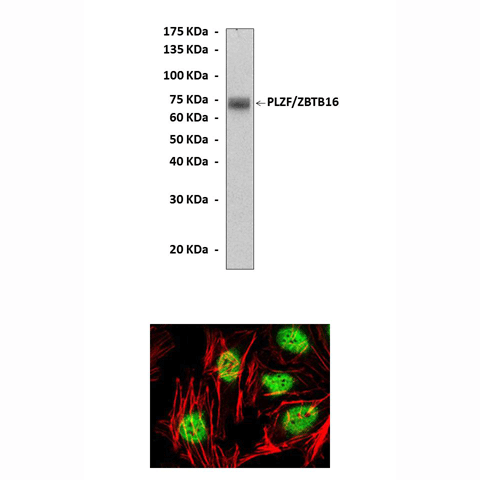Anti-PLZF/ZBTB16: Mouse PLZF/ZBTB16 Antibody
Mouse PLZF/ZBTB16 Antibody: Mouse PLZF/ZBTB16 Antibody
Size: 100 ul
Price: $413.00
Description
Regarding its function, a natural mutation (luxoid) in, and knock-out of, the mouse homologue Zfp145/ZBTB16 unraveled a crucial role in limb and skeletal patterning and spermatogonial stem cell maintenance. PLZF/ZBTB16 has further been implicated in tumor suppression in melanoma and prostate cancer, ascribed to its ability to cause cell cycle arrest and induce apoptosis in certain cell systems.2 The complex effects of PLZF/ZBTB16 have been associated with transcriptional repression of numerous genes such as members of the Hox family of transcription factors, kit, CRABPI, c-myc, CCNA2/Cyclin A, CDKN1B/p27/Kip1 and possibly others. Glucocorticoids (GCs) cause cell cycle arrest and apoptosis in lymphoid cells which is exploited to treat lymphoid malignancies. It was shown that PLZF/ZBTB16 is a glucocorticoid response gene in acute lymphoblastic leukemia. Thus, The suggested role of PLZF/ZBTB16 in cell cycle arrest and apoptosis induction in some systems, further supported a possible role of PLZF/ZBTB16 induction in the anti-leukemic glucocorticoid (GC) response.3 In addition, PLZF/ZBTB16 also plays a role in suppressing the proliferation of normal cultured human corneal endothelial cells. The expression of PLZF in HCECs is closely related to the formation of cell-cell contacts.4
2. Costoya, J.A. & Pandolfi, P.P.: Curr. Opin. Hematol. 8:212-7, 2001
3. Wasim, M. et al: J. Steroid Biochem. Mol. Biol. 120:218-27, 2010
4. Joko, T. et al: Mol. Vis. 13:649-58, 2007
Details
| Cat.No.: | CP10261 |
| Antigen: | Purified recombinant human PLZF/ZBTB16 fragments expressed in E. coli. |
| Isotype: | Mouse IgG1 |
| Species & predicted species cross- reactivity ( ): | Human, Mouse, Rat |
| Applications & Suggested starting dilutions:* | WB 1:1000 IP n/d IHC n/d ICC 1:50 – 1:200 FACS n/d |
| Predicted Molecular Weight of protein: | 74 kDa |
| Specificity/Sensitivity: | Detects PLZF/ZBTB16 proteins without cross-reactivity with other related proteins. |
| Storage: | Store at -20°C, 4°C for frequent use. Avoid repeated freeze-thaw cycles. |
*Optimal working dilutions must be determined by end user.




